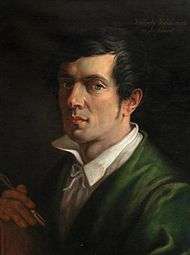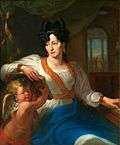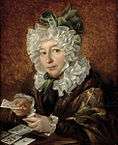Walenty Wańkowicz
Walenty Wańkowicz (Lithuanian: Valentinas Vankavičius, Belarusian: Валенты Ваньковіч; February 14, 1799 in Kałużyce - May 12, 1842 in Paris) was a Polish painter of Belarusan origin. He studied at the Jesuit College in Polotsk, the University of Wilno and the Imperial Academy of Arts in St. Petersburg. He was a representative of classicism and romanticism as well as a supporter of the embossed from the Wilno University art school.

Early life and studies
Wańkowicz was born on the family estate near Minsk, Russian Empire. His father was Melchior Wańkowicz, an agent working in Minsk judge. He was brought up in a Polish patriotic home, with Polish culture and Catholic faith, however, also with his Belarusian (Ruthenian) noble ancestry in mind. From 1811 the son attended, run by Jesuit Academy in Polotsk, where he was trained in civil and military architecture and drawing. His teacher was Jakub Pesling; Wańkowicz graduated here in 1817 with honors. In 1818 he enrolled at the University of Vilnius and studied here led by Jan Rustem and Jan Damel.[1]
Artistic career
From 1825 to 1829 he was then at the Academy of Arts in St. Petersburg in Aleksiej Yegorov and Vasily Szebujew. In Petersburg he made many friends with famous personalities among those from Congress Poland. One of these friends was the young but already famous poet Adam Mickiewicz, he portrayed the turn of the year 1827/1828 (Portrait of Adam Mickiewicz on the Ayu-Dag Cliff). Around this time also emerged Portraits of the Russian poet Alexander Pushkin, the pianist Maria Szymanowska as well as by the poet and satirist Antoni Gorecki ( an uncle of the artist).[1]
In the following years Wańkowicz lived in the nearby near Minsk in Ślepianka Mała and in Minsk itself, where he had a studio together with Jan Damel; from here he frequently traveled to Vilnius, whose Malszene exerted a great influence on the painters in Minsk. It created portraits of Towiańskis, the spouses Gutta and 1834, the allegorical portrait of Napoleon Napoleon before the fire (Polish: Napoleon przy ognisku). In recognition of his artistic achievements of the Senate appointed him in 1832 as a member of the Academy. By the end of 1839 he went abroad. In 1840 he lived for some time in Dresden, followed by short stays in Berlin, Munich, and Strasbourg. In 1841 he reached Paris, where he remained until his death. He renewed contact with at the Collège de France teaching Mickiewicz, who influenced him greatly. The philosopher and founder of champagne Andrzej Towiański affected him.[1]
Wańkowicz was buried in the Cimetière de Montmartre.
Wańkowicz painted mainly portraits (including miniatures), religious and historical pictures; latter with designs from the Napoleonic period. Classic elements with strong romantic tendencies for subjects such as the Scenic marks many of his works. The often imitated Mickiwicz painting was his outstanding performance and is attributable in its style of romantic Vilna Art School. He produced, among other things, a well-known portrait of Adam Mickiewicz (1827–28).[1]
Legacy
Wańkowicz is being honoured in Belarus as one of the most significant Belarusian painters of the 19th century.[2] There is a monument to him in Minsk.[3]
The Vankovich House / Wańkowicz House, the former mansion of the Wańkowicz family, is now a museum in the historical part of Minsk.[4]
Selected portraits
- Karol Lipiński (1822)
- Adam Mickiewicz (1828)
 Maria Szymanowska (1828)
Maria Szymanowska (1828) Woman Playing Solitaire (1829)
Woman Playing Solitaire (1829)
Sources
- M. Domański, Walenty Wańkowicz - artysta i przyjaciel Mickiewicza, "Rota", 1997 nr 4.
- Jan Marek Giżycki, Materyały do dziejów Akademii Połockiej i szkół od niej zależnych, 1905
See also
- List of painters by name
- List of Poles